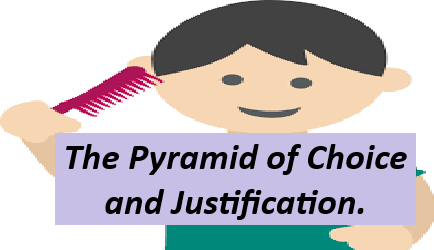The Pyramid of Choice and Justification.

The Pyramid of Choice and Justification.
It’s fascinating, and sometimes funny, to read doomsday predictions, but it’s even more fascinating to watch what happens to the reasoning of true believers when the prediction flops and the world keeps muddling along.
Notice that hardly anyone ever says,
- I blew it!
- I can’t believe how stupid I was to believe that nonsense”?
On the contrary, most of the time they become even more deeply convinced of their powers of prediction and choice.
Imagine two identical young men in terms of attitudes, abilities, and psychological health.
They are reasonably honest and have the same mediocre attitude toward, say, cheating.
They think it is not a good thing to do, but there are worse crimes in the world.
Now they are both taking an exam to determine whether they will get into graduate school.
They each draw a blank on a crucial essay question.
Failure looms … at which point each one gets an easy opportunity to cheat, by reading another student’s answers.
The two young men struggle with the temptation.
After a long moment of anguish, one yields and the other resists.
Their decisions are a hair’s breadth apart; it could easily have gone the other way for each of them.
Each gains something important, but at a cost:
- One gives up integrity for a good grade,
- The other gives up a good grade to preserve his integrity.
How do they feel about cheating a week later?
Each student has had ample time to justify the course of action he took.
The one who yielded to temptation will decide that cheating is not so great a crime.
He will say to himself:
- “Hey, everyone cheats.
- It’s no big deal.
- And I needed to do this for my future “
But the one who resisted the temptation will decide that cheating is far more immoral than he originally thought:
- In fact, people who cheat are disgraceful.
- In fact, people who cheat should be permanently expelled from school.
- We have to make an example of them.”
Also read: Hobbies and habits, and how they affect our daily lives.
By the time the students are through with their increasingly intense levels of self-justification, two things have happened:
- One, they are now very far apart from one another;
- And two, they have internalized their beliefs and are convinced that they have always felt that
It is as if they had started at the top of a pyramid, a millimeter apart;
But by the time they have finished justifying their actions, they have slid to the bottom and now stand at opposite corners of its base.
- The one who didn’t cheat considers the other to be immoral,
- And the one who cheated thinks the other is hopelessly puritanical.
This process illustrates how people who have been sorely tempted, battled temptation, and almost given in to it but resisted at the eleventh hour come to dislike, even despise, those who did not succeed in the same effort.
It’s the people who almost decide to live in glass houses who throw the first stones.
The metaphor of the pyramid applies to most important decisions involving moral choices or life options.
Instead of cheating on an exam, for example, now substitute:
- deciding to begin a casual affair (or not),
- sample an illegal drug (or not),
- take steroids to improve your athletic ability (or not),
- stay in a troubled marriage (or not),
- lie to protect your employer and job (or not),
- have children (or not),
- pursue a demanding career (or stay home with the kids).
When the person at the top of the pyramid is uncertain, when there are benefits and costs of both choices, then he or she will feel a particular urgency to justify the choice made.
But by the time the person is at the bottom of the pyramid, ambivalence will have morphed into certainty, and he or she will be miles away from anyone who took a different route.
This process blurs the distinction that people like to draw between “us good guys” and “those bad guys.”
Often, standing at the top of the pyramid, we are faced not with a black-and-white, go/ no-go decision, but with a gray choice whose consequences are shrouded.
The first steps along the path are morally ambiguous, and the right decision is not always clear.
We make an early, apparently inconsequential decision, and then we justify it to reduce the ambiguity of the choice.
This starts a process of entrapment action, justification, and further action that increases our intensity and commitment and may end up taking us far from our original intentions or principles.
The energy that produces the need to justify our actions and decisions, especially the wrong ones is an unpleasant feeling that Festinger called “cognitive dissonance.”
Cognitive dissonance is a state of tension that occurs whenever a person holds two cognitions (ideas, attitudes, beliefs, opinions) that are psychologically inconsistent.
Dissonance produces mental discomfort, ranging from minor pangs to deep anguish; people don’t rest easy until they find a way to reduce it.
In this example, the most direct way for a smoker to reduce dissonance is by quitting.
Join Enlighten Knowledge WhatsApp platform.
Join Enlighten Knowledge Telegram platform.









Awsome post and right to the point. I am not sure if this is actually the best place to ask but do you folks have any ideea where to get some professional writers? Thank you 🙂
Hey are using WordPress for your blog platform? I’m new to the blog world but I’m trying to get started and create my own. Do you require any html coding knowledge to make your own blog? Any help would be really appreciated!